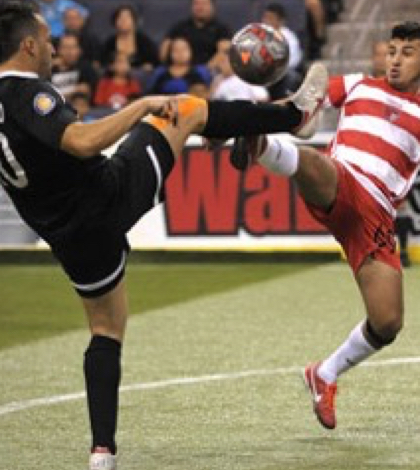The team, which plays its home games at Citizens Business Bank Arena, has seen its attendance rise, albeit slowly, since it arrived in the Inland Empire three years ago. Now if only it could get some media coverage.
Bernie Lilavois, president and head coach of the Ontario Fury, has a two-part vision for his indoor soccer team.
One part of that vision is Citizens Business Bank Arena filled to capacity whenever the Major Arena Soccer League Team, of which he is also part owner, plays its home games there.
The second part of Lilavois’ vision is about television.
He wants to see the Fury, and the MASL’s 19 other teams, playing on ESPN or another major network at least once a week. That would be a major undertaking: the league’s 20-game regular season starts in October and ends in March, so it would mean competing with the NFL, the NBA, NCAA football and basketball as well as local high school sports.
It would also mean going up against the World Series at the start of the soccer season, which this year is scheduled to begin Oct. 29 and finish March 5.
The Fury – which is about to start its fourth season in Ontario, having moved from Anaheim in 2012 – has a long way to go to reach either of those milestones.
The team typically plays before crowds of 3,500 at CBB Arena, well below capacity. Its television exposure is limited to internet streaming and some highlight reels on ESPN 3 and Go Live Sports Cast, a website that specializes in niche sports.
“With our marketing we have to go out and grind,” said Lilavois, 45, who played college soccer before he signed with the San Francisco Bay Blackhawks of the American Professional Soccer League, an outdoor league and the major professional soccer entity in the United States during the 1990s. “We have to get out and shake a lot of hands, meet a lot of people in the business community and we have to do it the year-round.
“We aren’t the Lakers or the Dodgers, where we can shut down during the off-season, come back when the next season starts and everyone remembers us.”
Also, the local print media doesn’t cover the Fury, being too busy writing about the region’s professional, college and high school teams.
Neither the Daily Bulletin nor the The Press-Enterprise has a beat writer assigned to the Inland Empire’s lone professional indoor soccer team, so the franchise gets scant print coverage at best, said Bill Norris, the Fury’s director of communications and media relations.
“The best we can do is get our scores in once in awhile.” said Norris, a former Daily Bulletin sportswriter and copy editor who joined the Fury in 2013. “We send them game stories but they don’t use them. They say they don’t have room, or the story gets to them at a bad time and it causes them deadline problems. It makes our marketing more difficult.”
Not being on television is one thing, but being ignored by your hometown print media – especially a sport as popular as soccer – is another issue entirely. The overall lack of media exposure can make marketing the Fury feel like pushing a boulder up a mountain, according to both men.
While it’s clearly a niche sport, indoor soccer is not new. The Major Indoor Soccer League formed in 1978 with six teams and eventually grew to 14 franchises.
During the 1980s the league’s games were broadcast on ESPN and the USA Network. MISL teams sometimes outdrew NBA and NHL franchises with which they shared markets, according to justsportsstats.com, a source of data related to North American professional sports.
The MISL became the premier professional soccer league in the United States after the North American Soccer League folded in 1984, but the indoor league was also doomed to fail because its strong franchises could not support its weaker ones. The MISL closed shop in 1992.
“It’s very hard to figure out,” Lilavois said, “I’m on the business side of things and I don’t understand it. Soccer is a growing sport, it’s getting more and more popular, but we’re still having a hard time getting coverage.”
There is room for optimism, however.
The Fury has performed well during its three years in Ontario, having made the playoffs during its second season and missing the post-season by one game last year. Attendance at Fury home games has gone up steadily since the team moved to Ontario, and the franchise is getting positive feedback from its fanbase.
“After games, every fan we interview says they want to come back,” Lilavois said. “The games are exciting, and it’s a good family environment. People like the product we’re providing.”
Perhaps most encouraging of all, a June 27 All-Star game between top indoor players from the United States and Mexico drew 7,000 fans to CBB Arena, a sign that Fury crowds should get bigger as its quality of play improves and the team becomes better known.
In the meantime, Fury officials can only keep marketing their team as best they can.
“The [Ontario] Reign have been very successful, and in a lot of ways we’re trying to follow their game plan,” Lilavois said. “You put on clinics, you go to all of the city events, you shake every hand you can. Justin Kemp [former Reign president] marched in Ontario’s Fourth of July parade every year. He was everywhere, and that’s what we’re trying to do.”
The Fury is marketing itself as well was any team in the MASL, especially considering the competition it faces and the other large-market obstacles it must overcome, Milliken said.
“They’re in the Los Angeles market, which is a lot bigger and a lot different than most markets,” Milliken said. “It’s an whole different animal, and they’re doing pretty well. If all of our teams marketed themselves the way the Fury does we wouldn’t have too many problems.”
Mark Christopher Auto Center in Ontario has invested heavily in the Fury, becoming the team’s title sponsor, said Christopher Leggio, president of the automobile agency.
That means “Mark Christopher Auto Center” appears on much of the team’s merchandising, is prominently displayed inside CBB Arena and is on the front of the team’s jersey.
“They represent our market, our demographic,” Leggio said. “We expect to be involved with them for a long time.”
 IE Business Daily Business news for the Inland Empire.
IE Business Daily Business news for the Inland Empire.


